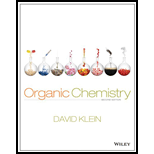
(a)
Interpretation:
Representation of proton transfer reaction by curved arrows with mentioning acids, bases and products of the given equilibrium reactions are needed to work out.
Concept introduction:
According to Bronsted-Lowry concept, acid is proton donor and base is proton acceptor. Curved arrows show the reaction mechanism of the acid-base reaction.
The mechanism of proton transfer always involves at least two curved arrows. One arrow should show the abstraction of hydrogen by the base and the other arrow shows the gain of negative charge by the acid.
The favored position of equilibrium is predicted by comparing the stability of the acids or the bases in each side of the given reactions.
The lone pair of conjugate base involving in resonance in a molecule will have greater stability as compared to bases having single anion. The stability is due to resonance stabilization energy.
To draw: the proton transfer reaction mechanism of the given reactions by using curved arrows with mentiontioning acid, bases and predict the direction of favored position of equilibrium.
(b)
Interpretation:
Representation of proton transfer reaction by curved arrows with mentioning acids, bases and products of the given equilibrium reactions are needed to work out.
Concept introduction:
According to Bronsted-Lowry concept, acid is proton donor and base is proton acceptor. Curved arrows show the reaction mechanism of the acid-base reaction.
The mechanism of proton transfer always involves at least two curved arrows. One arrow should show the abstraction of hydrogen by the base and the other arrow shows the gain of negative charge by the acid.
The favored position of equilibrium is predicted by comparing the stability of the acids or the bases in each side of the given reactions.
The lone pair of conjugate base involving in resonance in a molecule will have greater stability as compared to bases having single anion. The stability is due to resonance stabilization energy.
To draw: the proton transfer reaction mechanism of the given reactions by using curved arrows with mentiontioning acid, bases and predict the direction of favored position of equilibrium.
(c)
Interpretation:
Representation of proton transfer reaction by curved arrows with mentioning acids, bases and products of the given equilibrium reactions are needed to work out.
Concept introduction:
According to Bronsted-Lowry concept, acid is proton donor and base is proton acceptor. Curved arrows show the reaction mechanism of the acid-base reaction.
The mechanism of proton transfer always involves at least two curved arrows. One arrow should show the abstraction of hydrogen by the base and the other arrow shows the gain of negative charge by the acid.
The favored position of equilibrium is predicted by comparing the stability of the acids or the bases in each side of the given reactions.
The lone pair of conjugate base involving in resonance in a molecule will have greater stability as compared to bases having single anion. The stability is due to resonance stabilization energy.
To draw: the proton transfer reaction mechanism of the given reactions by using curved arrows with mentiontioning acid, bases and predict the direction of favored position of equilibrium.
Want to see the full answer?
Check out a sample textbook solution
Chapter 3 Solutions
Organic Chemistry
- Provide the reagents for the following reactions.arrow_forwardIf I have 1-bromopropene, to obtain compound Z, I have to add two compounds A1 and A2. Indicate which compounds are needed. P(C6H5)3arrow_forwardDraw the major product of this reaction. Ignore inorganic byproducts. Assume that the water side product is continuously removed to drive the reaction toward products. O CH3CH2NH2, TSOH Select to Draw >arrow_forward
- Indicate the products obtained by reacting fluorobenzene with a sulfonitric mixture.arrow_forwardIf I have 1-bromopropene, to obtain compound A, I have to add NaOH and another compound. Indicate which compound that would be. C6H5 CH3arrow_forwardIf I have 1-bromopropene and I want to obtain (1,1-dipropoxyethyl)benzene, indicate the compound that I should add in addition to NaOH.arrow_forward
- Draw the major product of this reaction. Ignore inorganic byproducts. Ο HSCH2CH2CH2SH, BF3 Select to Draw I Submitarrow_forwardFeedback (7/10) Draw the major product of this reaction. Ignore inorganic byproducts. Assume that the water side product is continuously removed to drive the reaction toward products. Incorrect, 3 attempts remaining Ο (CH3CH2)2NH, TSOH Select to Draw V N. 87% Retryarrow_forwardIf I want to obtain (1,1-dipropoxyethyl)benzene from 1-bromopropene, indicate the product that I have to add in addition to NaOH.arrow_forward
 ChemistryChemistryISBN:9781305957404Author:Steven S. Zumdahl, Susan A. Zumdahl, Donald J. DeCostePublisher:Cengage Learning
ChemistryChemistryISBN:9781305957404Author:Steven S. Zumdahl, Susan A. Zumdahl, Donald J. DeCostePublisher:Cengage Learning ChemistryChemistryISBN:9781259911156Author:Raymond Chang Dr., Jason Overby ProfessorPublisher:McGraw-Hill Education
ChemistryChemistryISBN:9781259911156Author:Raymond Chang Dr., Jason Overby ProfessorPublisher:McGraw-Hill Education Principles of Instrumental AnalysisChemistryISBN:9781305577213Author:Douglas A. Skoog, F. James Holler, Stanley R. CrouchPublisher:Cengage Learning
Principles of Instrumental AnalysisChemistryISBN:9781305577213Author:Douglas A. Skoog, F. James Holler, Stanley R. CrouchPublisher:Cengage Learning Organic ChemistryChemistryISBN:9780078021558Author:Janice Gorzynski Smith Dr.Publisher:McGraw-Hill Education
Organic ChemistryChemistryISBN:9780078021558Author:Janice Gorzynski Smith Dr.Publisher:McGraw-Hill Education Chemistry: Principles and ReactionsChemistryISBN:9781305079373Author:William L. Masterton, Cecile N. HurleyPublisher:Cengage Learning
Chemistry: Principles and ReactionsChemistryISBN:9781305079373Author:William L. Masterton, Cecile N. HurleyPublisher:Cengage Learning Elementary Principles of Chemical Processes, Bind...ChemistryISBN:9781118431221Author:Richard M. Felder, Ronald W. Rousseau, Lisa G. BullardPublisher:WILEY
Elementary Principles of Chemical Processes, Bind...ChemistryISBN:9781118431221Author:Richard M. Felder, Ronald W. Rousseau, Lisa G. BullardPublisher:WILEY





